The Apple iPad 2 Review
by Brian Klug, Anand Lal Shimpi & Vivek Gowri on March 19, 2011 8:01 PM ESTThe GPU: Apple's Gift to Game Developers
The GPU side of the A5 is really what's most exciting. As we mentioned in our iPad 2 GPU Performance analysis, the A5 includes a dual-core PowerVR SGX 543 - also known as the SGX 543MP2. In our earlier article we showed the SGX 543MP2 easily beating both an iPad 1 and the Tegra 2 based Motorola Xoom.
To understand why the SGX 543MP2 has such a performance advantage we need to first remember that NVIDIA's Tegra 2 is nearly a year late. NVIDIA's first competitive ultra mobile GPU was supposed to be shipping in products in the first half of 2010, instead it found itself shipping in 2011. While NVIDIA is good at designing GPUs, it's not good enough that it can release a product and maintain a two year performance advantage over the competition. Let's look at the architecture, shall we?
NVIDIA's Tegra 2 features a DirectX 9-class GPU. NVIDIA used to call it the GeForce ULP (Ultra Low Power) but now it's just GeForce. As a DX9 class GPU we're dealing with a conventional, non-unified shader architecture. While all OpenGL ES 2.0 GPUs can execute pixel and vertex shader instructions, the GeForce in Tegra 2 runs pixel and vertex shaders on separate groups of hardware.

NVIDIA calls each pixel and vertex shader ALU a core. The Tegra 2 has four pixel shader cores and four vertex shader cores. The four pixel shader ALUs make up a single Vec4 and the same goes for the four vertex shader ALUs. NVIDIA wouldn't elaborate on what limitations exist when dispatching operations to the cores. All pixel shader operations happen at 20-bits per component precision while all vertex shader operations happen at 32-bits per component.
Each core is capable of executing one multiply+add (MAD) operation per clock. Do the math and that works out to be a peak rate of 8 MADs per clock for the entire GPU. The maximum operating frequency for the Tegra 2 GeForce GPU is 300MHz, however device vendors may run the GPU at a lower frequency to save on power. At 300MHz this works out to be 4.8 GFLOPS (counting a MAD as two FLOPs).
Imagination Technologies' PowerVR SGX 543MP2 is fundamentally a bigger GPU than the GeForce in NVIDIA's Tegra 2. Let's go through the math.
The SGX 543 features four USSE2 pipes. This is a unified shader architecture so both vertex and pixel shader code runs on the same set of hardware. The benefit of this approach is you get better performance in peaky situations where you're running a lot of vertex or pixel shader code and not a balance that's perfectly tailored to your architecture. The Tegra 2 will only run at peak efficiency if it encounters a mix of 50% vertex and 50% pixel shader code. The PowerVR SGX series will never have any of its execution pipes idle regardless of the instruction mix.
Each USSE2 pipe has a 4-wide vector ALU capable of cranking out 4 MADs per clock. Two of these pipes is enough to equal the peak throughput of what NVIDIA built in Tegra 2, but the PowerVR SGX 543 has four of them. As for the MP2? Go ahead and double that number again. The SGX 543MP2 is simply two 543s placed next to one another.
All of this works out to be 16 MADs per clock for the SGX 543 and 32 MADs per clock for the SGX 543MP2. At 200MHz that's 12.8GFLOPS and at 250MHz we're talking about 16 GFLOPS.
| Mobile SoC GPU Comparison | |||||||||
| PowerVR SGX 530 | PowerVR SGX 535 | PowerVR SGX 540 | PowerVR SGX 543 | PowerVR SGX 543MP2 | GeForce ULP | Kal-El GeForce | |||
| SIMD Name | USSE | USSE | USSE | USSE2 | USSE2 | Core | Core | ||
| # of SIMDs | 2 | 2 | 4 | 4 | 8 | 8 | 12 | ||
| MADs per SIMD | 2 | 2 | 2 | 4 | 4 | 1 | ? | ||
| Total MADs | 4 | 4 | 8 | 16 | 32 | 8 | ? | ||
| GFLOPS @ 200MHz | 1.6 GFLOPS | 1.6 GFLOPS | 3.2 GFLOPS | 6.4 GFLOPS | 12.8 GFLOPS | 3.2 GFLOPS | ? | ||
| GFLOPS @ 300MHz | 2.4 GFLOPS | 2.4 GFLOPS | 4.8 GFLOPS | 9.6 GFLOPS | 19.2 GFLOPS | 4.8 GFLOPS | ? | ||
At its lowest expected clock speed, the 543MP2 already has over twice the compute power of the Tegra 2's GPU at its highest operating frequency. Take into account the fact that the A5 likely has more memory bandwidth than Tegra 2 and the SGX 543MP2 is a tile based architecture with lower bandwidth requirements and the performance numbers we talked about last time shouldn't be all that surprising.
The real competition for the SGX 543MP2 will be NVIDIA's Kal-El. That part is expected to ship on time and will feature a boost in core count: from 8 to 12. The ratio of pixel to vertex shader cores is not known at this point but I'm guessing it won't be balanced anymore. NVIDIA is promising 3x the GPU performance out of Kal-El so I suspect that we'll see an increase in throughput per core.
GPU Performance
Taken from our iPad 2 GPU Performance Preview:
As always we turn to GLBenchmark 2.0, a benchmark crafted by a bunch of developers who either have or had experience doing development work for some of the big dev houses in the industry. We'll start with some of the synthetics.
Over the course of PC gaming evolution we noticed a significant increase in geometry complexity. We'll likely see a similar evolution with games in the ultra mobile space, and as a result this next round of ultra mobile GPUs will seriously ramp up geometry performance.
Here we look at two different geometry tests amounting to the (almost) best and worst case triangle throughput measured by GLBenchmark 2.0. First we have the best case scenario - a textured triangle:
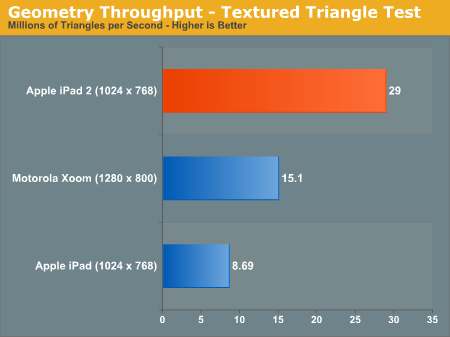
The original iPad could manage 8.7 million triangles per second in this test. The iPad 2? 29 million. An increase of over 3x. Developers with existing titles on the iPad could conceivably triple geometry complexity with no impact on performance on the iPad 2.
Now for the more complex case - a fragment lit triangle test:
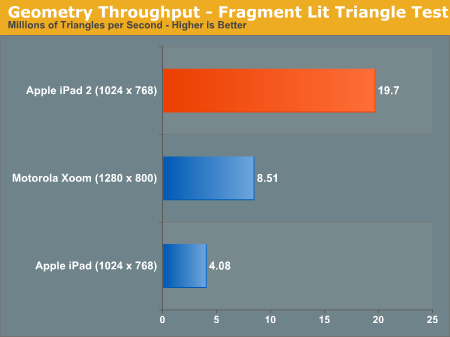
The performance gap widens. While the PowerVR SGX 535 in the A4 could barely break 4 million triangles per second in this test, the PowerVR SGX 543MP2 in the A5 manages just under 20 million. There's just no competition here.
I mentioned an improvement in texturing performance earlier. The GLBenchmark texture fetch test puts numbers to that statement:
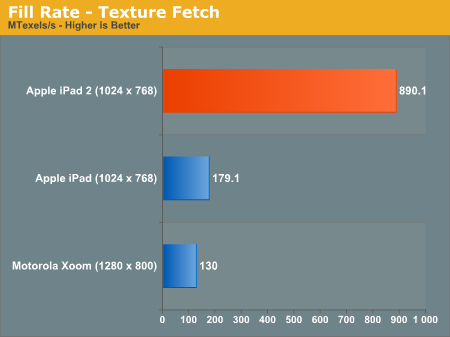
We're talking about nearly a 5x increase in texture fetch performance. This has to be due to more than an increase in the amount of texturing hardware. An improvement in throughput? Increase in memory bandwidth? It's tough to say without knowing more at this point.
| Apple iPad vs. iPad 2 | ||||
| Apple iPad (PowerVR SGX 535) | Apple iPad 2 (PowerVR SGX 543MP2) | |||
| Array test - uniform array access |
3412.4 kVertex/s
|
3864.0 kVertex/s
|
||
| Branching test - balanced |
2002.2 kShaders/s
|
11412.4 kShaders/s
|
||
| Branching test - fragment weighted |
5784.3 kFragments/s
|
22402.6kFragments/s
|
||
| Branching test - vertex weighted |
3905.9 kVertex/s
|
3870.6 kVertex/s
|
||
| Common test - balanced |
1025.3 kShaders/s
|
4092.5 kShaders/s
|
||
| Common test - fragment weighted |
1603.7 kFragments/s
|
3708.2 kFragments/s
|
||
| Common test - vertex weighted |
1516.6 kVertex/s
|
3714.0 kVertex/s
|
||
| Geometric test - balanced |
1276.2 kShaders/s
|
6238.4 kShaders/s
|
||
| Geometric test - fragment weighted |
2000.6 kFragments/s
|
6382.0 kFragments/s
|
||
| Geometric test - vertex weighted |
1921.5 kVertex/s
|
3780.9 kVertex/s
|
||
| Exponential test - balanced |
2013.2 kShaders/s
|
11758.0 kShaders/s
|
||
| Exponential test - fragment weighted |
3632.3 kFragments/s
|
11151.8 kFragments/s
|
||
| Exponential test - vertex weighted |
3118.1 kVertex/s
|
3634.1 kVertex/s
|
||
| Fill test - texture fetch |
179116.2 kTexels/s
|
890077.6 kTexels/s
|
||
| For loop test - balanced |
1295.1 kShaders/s
|
3719.1 kShaders/s
|
||
| For loop test - fragment weighted |
1777.3 kFragments/s
|
6182.8 kFragments/s
|
||
| For loop test - vertex weighted |
1418.3 kVertex/s
|
3813.5 kVertex/s
|
||
| Triangle test - textured |
8691.5 kTriangles/s
|
29019.9 kTriangles/s
|
||
| Triangle test - textured, fragment lit |
4084.9 kTriangles/s
|
19695.8 kTriangles/s
|
||
| Triangle test - textured, vertex lit |
6912.4 kTriangles/s
|
20907.1 kTriangles/s
|
||
| Triangle test - white |
9621.7 kTriangles/s
|
29771.1 kTriangles/s
|
||
| Trigonometric test - balanced |
1292.6 kShaders/s
|
3249.9 kShaders/s
|
||
| Trigonometric test - fragment weighted |
1103.9 kFragments/s
|
3502.5 kFragments/s
|
||
| Trigonometric test - vertex weighted |
1018.8 kVertex/s
|
3091.7 kVertex/s
|
||
| Swapbuffer Speed |
600
|
599
|
||
Enough with the synthetics - how much of an improvement does all of this yield in the actual GLBenchmark 2.0 game tests? Oh it's big.
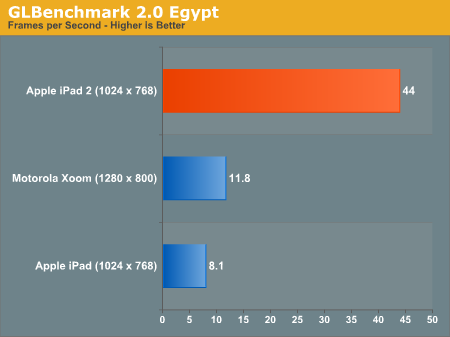
Without AA, the Egypt test runs at 5.4x the frame rate of the original iPad. It's even 3.7x the speed of the Tegra 2 in the Xoom running at 1280 x 800 (granted that's an iOS vs. Android comparison as well).
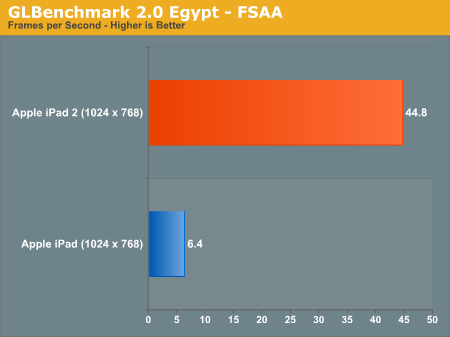
With AA enabled the iPad 2 advantage grows to 7x. In a game with the complexity of the Egypt test the original iPad wouldn't be remotely playable while the iPad 2 could run it smoothly.
The Pro test is a little more reasonable, showing a 3 - 4x increase in performance compared to the original iPad:
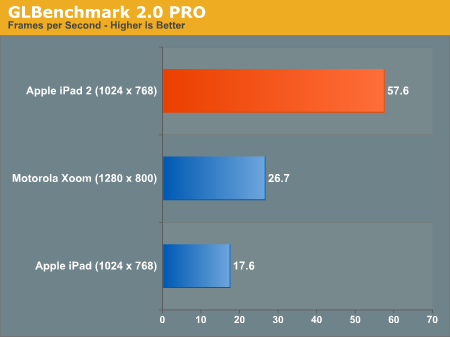
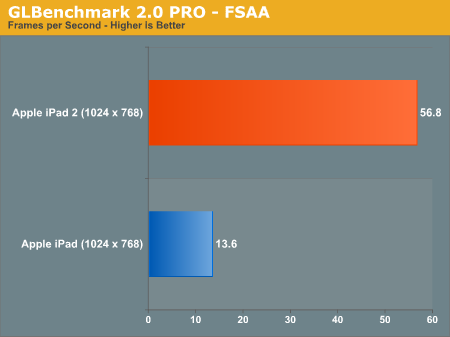
While we weren't able to reach the 9x figure claimed by Apple (I'm not sure that you'll ever see 9x running real game code), a range of 3 - 7x in GLBenchmark 2.0 is more reasonable. In practice I'd expect something less than 5x but that's nothing to complain about.











189 Comments
View All Comments
Shadowmaster625 - Monday, March 21, 2011 - link
If that is true then why not focus on that? I still have yet to read anything on anandtech about remote desktop on a tablet. How powerful does a tablet need to be to stream 1-2 mbps compressed images of my desktop over wifi? I can skin my desktop to make it look more like a mobile OS. Touch commands can be fairly easily emulated and transposed into mouse commands. Audio doesnt require much bandwidth. Only video would present a problem, but even then it really doesnt take all that much hardware to play a video. Yet all I see are horrible implementations of remote desktop.marc1000 - Monday, March 21, 2011 - link
i remember reading here at AT that the Nokia N8 could be used to drive an HDMI display and hooked to an keyboard/mouse, to "simulate" a pc-like experience . and now the Ipad2 does the same thing, but 1 year later.IMHO all that apple does is beautifull, but they charge the price for the "beautifullness" of their products.
well, I just want a tablet/smartphone that works, so I will wait until these prices drop... until then I will live with my Htc HD (1st gen.. ugly!)
Watwatwat - Monday, March 21, 2011 - link
almost feels like i learned something:DJayman30 - Monday, March 21, 2011 - link
Maybe the iPad doesnt fit into a busy techbloggers "workflow" but as a consumer device it's an incredible gadget. My ipad 1 is used daily and has never sat on a shelf unused for more than a few hours. I reach for it first instead of my iPhone or clunky Gateway laptop for 90% of my daily computing needs. It has incredible performance, portability, battery life, and overall utility.I can buy & read books, download and play great games, movies and music quickly and easily. Great Email and web surfing are just icing on the cake! Works great for me!
FYI. iPad 1 costs $399 now.
cotak - Tuesday, March 22, 2011 - link
I am with the staff at anand. I use an iPhone 4. It's nice fo getting a little reading of news etc done. And I have looked at the iPad and I have consider getting one. And likely I will have one but not for myself. It'll be too limiting for me to use. For my fiancee though it's perfect since on a regular week she can go 5 6 days without powering up her computer.So is there s market for tablets? Maybe but I don't think it's big as various peope like to think it could be. And the fall out from that might be pretty big. Nvidia's betting on it, moto has only recently make it back into the black, and rim seems to have concentrated on the playbook over improving their last series of phone release. So maybe some of these players might not be be best stocks to hold for the medium term...
Anyhow tablets are useful for light use. But for people who use their devices/technology enought to justify spending regularly on technology, it might be too small and too slow. And really isn't the repeat buyer the important one I the market? My fiancee could get a iPad 1 and happly use it for the next 6 years without considering buying a new one. If people like that are the market, it's not going to be as big as some people in wall street seems to think.
vshin - Tuesday, March 22, 2011 - link
The one thing I'm surprised that isn't getting as much coverage is that small text is actually harder to read on the Ipad 2 than on the Ipad 1. Some folks chalk this up to being "spoiled" by the Iphone 4's retina display but it's actually because Ipad 2 implements heavy use of anti-aliasing, which can't be configured or turned off. I find my eyes tiring very easily as I browse the web or read on iBook in portrait mode.speedkills - Tuesday, March 22, 2011 - link
I noticed over and over in the review people came back to the point that the current app switching functionality is a very poor user experience. It's too bad Apple isn't enabling the multi-touch gestures for multi-tasking by default as they work very well and while they are not for general release it would be nice to see Anandtech weigh on them to see if they feel they should be included in iOS 5 or if they feel a better implementation is needed.Personally both my girlfriend and I have been using them and absolutely loving them. A four finger swipe up shows the multi-tasking bar instead of having to use the double-tap but 95% of the time a simple four finger swipe left or right is sufficient swapping between your most recently used apps. It makes it very easy to do something like copy a bit of text out of a web page, swipe over to Evernote and make a note, then swipe back to Safari and continue surfing.
It's really too bad Apple chose to hide them by default (my guess is they want to save them for the iPhone release to make iOS 5 look like a bigger jump in functionality) because they are a great and much needed addition to the iPad 2.
Mac Ike - Tuesday, March 22, 2011 - link
First of all this was great and extensive review,thank you very much! I have used Windows computers everyday at Work since Windows 3.1,I enjoy all Computers,but Macs are more stable more elegant,easier-to-use,and hold their value longer! I'm not trying to make Windows-users/lovers change to my preferences. I have not purchased an ipad yet,even though I can see many uses for it,and enjoy using iPads. I want ALL OF THE POWER I could possibly need with me,at all times,so I carry my 17-inch MacBook Pro for those times; when not practical I carry my iphone 4. Serious workloads might send me to my imac,it deprnds on ehere I am and what i need to do or what I can do in the environment that I'm in.Since I enjoyed the ipad 1,it only stands to reason that I would enjoy ipad 2,because the speed increase,cameras,weight-reduction,...can only enhance the experience! I am always amazed by the rude,idiotic,self-centered opinions and insults expressed on these Forums! If YOU don't want or need an ipad (or iPhone/Mac),then buy what YOU like! Why insult someone else,for THEIR DECISIONS or PURCHASES?? it's almost always a cheaper or alternative choices you can make. I give less than a Damn if you like another brand more,or feel that Apple's prices are too high!! If you want a cheaper computer,don't need a tablet,can't see the value of design/workmanship/elegance of OS &Hardware,hardware-software integration,good,buy your low-priced,cheap shit,and leave the rest of us alone,so that we can enjoy what WE LIKE! I don't ask any Apple-Haters or Fence-Sitters to purchase my products for me,so it's just amazing how people feel that you're an Apple-Fan Boy or Girl if you prefer Apple products! If I want a $60,000 Car,and you feel it's worth it(V-8 or not),and you can get a car for $20,000,why should your choice determine mine?? If you Windows-trolls don't like Apple-gear,why come to Apple-topics to complain about SOMEONE ELSE's choices?? Rude,immature,and Stupid!
rice2999 - Tuesday, March 22, 2011 - link
Dear anandThere is nothing about screen brightness setting to go with the battery life testing. Did you use 50% default brightness? Xoom screen is dimmer than ipad/ipad2. Though it can be argued, it is not exactly fair to compare battery life while the screen is on different brightness, since screen is probably the one uses the most battery.
I forget where I saw it, someone else actually used a meter to measure the brightness and adjusted the brightness to the same before testing the battery life.
Sabresiberian - Wednesday, March 23, 2011 - link
Every editor said what I've been saying all along about tablets - they are coolz toyz, but when people start trying to use them, they will find they aren't as handy as either a laptop or a smartphone and they'll be returned or be gathering dust somewhere. Except for niche uses, such as book readers and possibly media device controllers in the home, something like that, tablets are a fad - in my opinion, of course.That being said, they do have innovative technologies I think notebook manufacturers should pay strong attention to and add to their products (netbooks and notebooks). There are things the netbook/notebook can do a tablet's form factor prohibits (add a keyboard to a tablet and it really isn't a tablet any more now, is it?), but there is no reason the notebook should lack any feature a tablet has (except to save money on very low-priced budget models).
As to this thing having enough power to replace a "mainstream" computer if attached to a monitor and keyboard - right. I'll run out right now and buy one to play World of Warcraft on - or isn't that "mainstream" enough for you?
Won't be long now and a device this size will be able to replace what we consider to be a power-house PC these days - but then what will the power-house PC build be like then?
;)